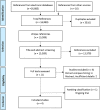Timing of oxytocin administration to prevent post-partum hemorrhage in women delivered by cesarean section: A systematic review and metanalysis
- PMID: 34081734
- PMCID: PMC8174699
- DOI: 10.1371/journal.pone.0252491
Timing of oxytocin administration to prevent post-partum hemorrhage in women delivered by cesarean section: A systematic review and metanalysis
Abstract
Background: There is no consensus on the best timing for prophylactic oxytocin administration during cesarean section (CS) to prevent post-partum hemorrhage (PPH).
Objectives: Assess the effects of administrating prophylactic oxytocin at different times during CS.
Methods: We searched nine databases to identify relevant randomized controlled trials (RCT). We pooled results and calculated average risk ratios (RR), mean differences (MD), and 95% confidence intervals (CI). We used GRADE to assess the overall evidence certainty.
Results: We screened 13,389 references and included four trials. We found no statistically significant differences between oxytocin given before versus after fetal delivery on PPH (RR 0.60, 95%CI 0.15-2.47; 1 RCT, N = 300) or nausea/vomiting (RR 1.21, 95%CI 0.69-2.13; 1 RCT, N = 300). There was a significant reduction in the need for additional uterotonics when oxytocin was given immediately before uterine incision versus after fetal delivery (RR 0.37, 95%CI 0.18-0.73; I2 = 0%; 2 RCTs; N = 301). Oxytocin given before fetal delivery significantly reduced intra-operative blood loss (MD -146.77mL, 95%CI -168.10 to -125.43; I2 = 0%; 3 RCTs, N = 601) but did not change the incidence of blood transfusion (RR 0.50, 95%CI 0.13-1.95; I2 = 0%; 2 RCTs, N = 301) or hysterectomy (RR 3.00; 95%CI 0.12-72.77; I2 = 0%; 2 RCTs, N = 301). One trial (N = 100) compared prophylactic oxytocin before versus after placental separation and found no significant differences on PPH, additional uterotonics, or nausea/vomiting.
Conclusions: In women having pre-labor CS, there is limited evidence indicating no significant differences between prophylactic oxytocin given before versus after fetal delivery on PPH, nausea/vomiting, blood transfusion, or hysterectomy. Earlier oxytocin administration may reduce the volume of blood loss and need for additional uterotonics. There is very limited evidence suggesting no significant differences between prophylactic oxytocin given before versus after placental separation on PPH, need for additional uterotonic, or nausea/vomiting. The overall certainty of the evidence was mostly low or very low due to imprecision. Protocol: CRD42020186797.
Conflict of interest statement
The authors have declared that no competing interests exist.
Figures






References
-
- World Health Organization. WHO recommendations: uterotonics for the prevention of postpartum haemorrhage. Geneva: World Health Organization; 2018. Licence: CC BY-NC-SA 3.0 IGO. - PubMed
-
- Parant O, Guerby P, Bayoumeu F. [Obstetric and anesthetic specificities in the management of a postpartum hemorrhage (PPH) associated with cesarean section]. J Gynecol Obstet Biol Reprod (Paris). 2014;43(10):1104–22. - PubMed
Publication types
MeSH terms
Substances
Grants and funding
LinkOut - more resources
Full Text Sources

